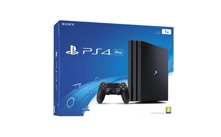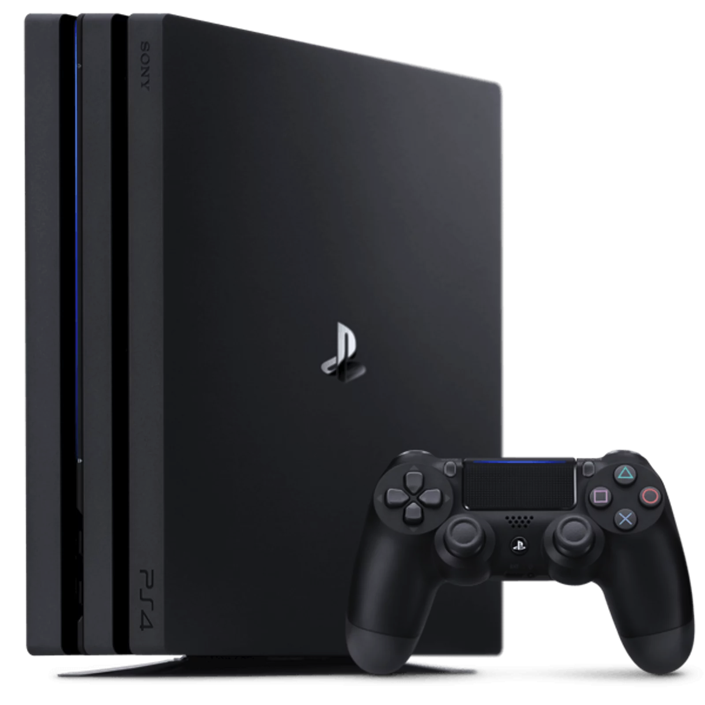 Released in November 2016, the PS4 Pro was a worthy upgrade from its predecessor given all the upgrades, including its ability to connect to 4k televisions. Of course time, as well as technology, has since moved on, and the PS4 Pro has now been replaced by the ever famous, and notoriously hard to find, PS5 console. Whilst you may be able to find some great deals on the PS4 Pro console, please note that Sony discontinued making all PS4 consoles in January 2021 so our advice would be to splurge on the PS5.
Released in November 2016, the PS4 Pro was a worthy upgrade from its predecessor given all the upgrades, including its ability to connect to 4k televisions. Of course time, as well as technology, has since moved on, and the PS4 Pro has now been replaced by the ever famous, and notoriously hard to find, PS5 console. Whilst you may be able to find some great deals on the PS4 Pro console, please note that Sony discontinued making all PS4 consoles in January 2021 so our advice would be to splurge on the PS5.
Latest Playstation Console: PS5
Shops With PS4 Pro Offers
PS4 Pro Buying Guide

Ever since it was released in November of 2013 the PlayStation 4 has been considered to be one of the best games consoles on the market. Just as the new version of the machine was released at around the same time as the Xbox One, so too have Sony decided to introduce a newer model at a similar time to Microsoft’s decision to upgrade their console to the Xbox One S.
Are there major differences between the PS4 Pro and its older sibling, though, or is it a matter of incremental changes to keep up with changing technologies? Here we’ll have a little look at the pros and cons of looking to upgrade your console to the latest and greatest, explaining the differences between the newer and older models as well has having a look at the specs of Sony’s flagship gaming machine.
PS4 Pro: What’s New?
The Internal Workings
As always with new models of popular technological devices, the rumors around the latest Sony offering had been swirling through forums and online chat rooms for months before the details were confirmed. It had a working title of the ‘PS4 Neo’, perhaps as a nod to the character of the same name from The Matrix film series. Was it to be an entirely new generation of PlayStation consoles? Or merely a slight improvement on the previous machine with a bit more memory and slightly faster chips?
What we will say straight away is that it is not the first in a new generation of consoles. That said, it is a hugely different machine to the original PS4, keeping little but its predecessors name and OS. The PS4 Pro contains an AMD Polaris architecture GPU that Sony claims is two times faster than the GPU in the older model. That means the PS4 Pro will work faster, have less frame rate issues in heavy workload games and generally be a much smoother experience in-game.
What ties the new machine in with the older one is that developers have been informed that they cannot make PS4 Pro-only games. All new titles must be able to be played on the original PS4, though they can offer improvements that are exclusive to the PS4 Pro like better resolutions. ‘Pro-Enhanced’ versions of games will be identifiable by a specific logo on the packaging that you’ll need to keep your eye out for.
4K
The biggest improvement that the PS4 Pro will bring is the move to 4K resolution gaming. That means that users with a 4K ready TV will be able to play games in quality that is pretty much double the 1080p resolution of the HD PS4. It’s not a perfect move, however, with a number of issues giving potential consumers pause for thought.
The first problem is in the manner in which games will be able to be played in 4K. Though the PS4 Pro does have the ability to allow you to play in 4K with High Dynamic Ranger, the resolution’s usage will be inconsistent at best. Most games will actually merely be upscaled to near-4K from 1080p rather than played with a native 4K resolution.
Yes, the upscaling of 1080p images to near-4K will give you an impressive quality image, but it’s far from the visual perfection that videophiles will be expecting. The PS4 Pro’s GPU won’t be good enough to cope with graphic intensive games in native 4K, meaning that it will be the older titles that will have it natively and the rest will merely be upscaled. Not ideal, truth be told.
Another problem potential buyers will want to bear in mind is that the PS4 Pro will not work as a UHD Blu-ray player. You’ll be able to watch 4K through services such as YouTube and Netflix, you won’t be able to play UHD Blue-rays on the machine, so you’ll have to buy a 4K Blu-ray player separately. Given that the Xbox One S does work as a 4K Blu-ray player, that may turn out to be a decision that Sony come to regret when the sales figures for each device come through further down the line.
Sony are banking on the fact that most people stream their video contents nowadays and that the uprising of 4K options on Netflix, Amazon Video and, of course, PlayStation Video will make Blu-ray players as good as obsolete in the future. It’s a risky gamble to take, however, considering people who value video quality take it very seriously. It also backs up the notion that the PS4 claims to be a 4K console but it seems to lack some crucial 4K features.
Virtual Reality
Many people believe that virtual reality is the future of gaming, if not TV watching itself. The PS4 Pro certainly seems to buy into that notion, ensuring that Sony’s latest device will work better with VR than any console before it. The PS VR will offer smoother gaming combined with a consistent frame rate and higher resolution on the PS4 Pro than the PS4 itself could ever hope to manager.
If you’re the sort of person that believes in the viability of virtual reality or, at the very least, wants to future proof themselves against this emerging technology then the PS4 Pro will be worthy of your consideration. The fact that Sony have told developers that any VR game needs to run at a minimum of 60fps in order to ensure there’s no lag or risk of inducing motion sickness means that the older PS4 will be as good as useless with any new VR-specific titles because of its lack of power.
External Changes
Sony have made another interesting decision when it comes to the design of the PS4 Pro. Where Microsoft chose to make the Xbox One S around half the size of the Xbox One, Sony have added some heft to their newest machine. This is perhaps in part because they’ve also decided to release a new slimmed down version of the PS4 for users who might want a thinner device than the original PS4.
The PS4 Pro comes in at 295mm x 55mm x 327mm and weighs 3.3kg. Compare that to the 265mm x 39mm x 288mm of the slimmer new PS4 and you’ll see just what the difference will be in sizing. 30mm off the width, 16mm off the height and 39mm off the depth is no small amount when you’re talking about a console that has to fit into your home entertainment surroundings.
Other Things of Note
One of the most important things with any games console is the controller. PS4 Pro users will, therefore, be either pleased or annoyed to discover that very little of note will be done to the controller of the new device. A light has been moved to a position just above the touchpad, but otherwise things remain pretty much the same.
The fact that games need to be able to be played on older PS4s as well as the PS4 Pro means that developers will have to invest a huge amount of manpower into getting things right. Creating a game that can be played on two different consoles with widely differing technical specifications is no mean feat, so we probably won’t really be able to put the PS4 Pro through its paces until some time in 2017 when games-makers have had a chance to investigate the new machine’s potential.
Should I Upgrade from PS4 to PS4 Pro?
The PS4 Pro is not the start of a whole new generation of consoles. Because of that, you’ll want to think carefully about whether or not it’s for you if you’ve already got a PS4. That all games need to be playable on the PS4 is a good decision from Sony in order to avoid annoying its current customer base, but it also means that people have no specific need to buy the new device.
The company’s halfway-house approach to 4K will also limit people’s desire to upgrade. If you’ve got a 4K television and you don’t yet own a member of the PlayStation family then it will make sense to buy the PS4 Pro. If you don’t have a suitable TV, though, or you’ve been playing on your PS4 plenty since the end of 2013 and have never felt that the graphics have been found wanting then this is probably not for you. The need to buy a new television as well as the device to get the most out of it makes it a very costly investment.
Graphics will be improved, games will look much better and run a lot smoother, but the changes are much more incremental than heavy gamers will be happy with. It’s not a home run but then neither is the Xbox One S, so Sony will be reasonably confident of bringing in plenty of users moving forward.



